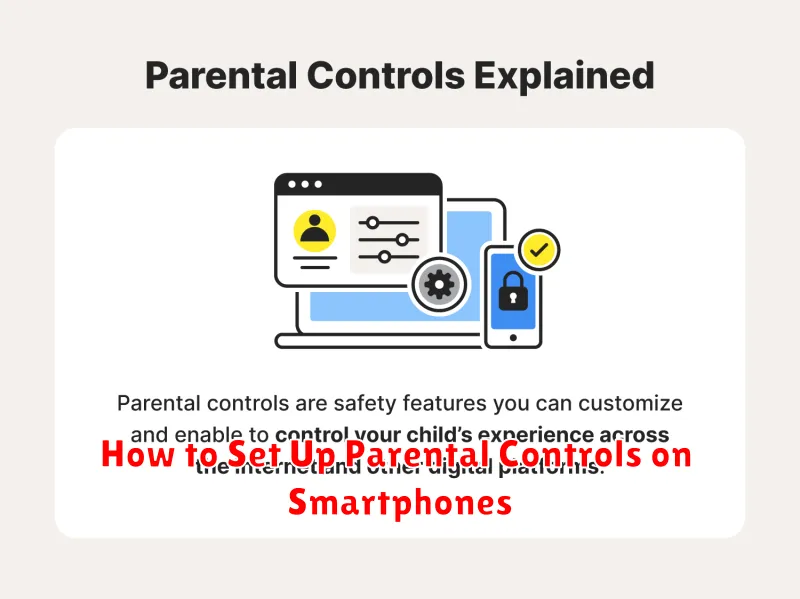In today’s digital age, smartphones have become ubiquitous, impacting even the youngest members of our families. With children gaining access to these powerful devices at increasingly younger ages, it’s more important than ever for parents to understand how to implement and utilize parental controls. These controls offer a vital layer of protection, enabling parents to manage their children’s smartphone usage and safeguard them from potentially harmful content, inappropriate apps, excessive screen time, and online predators. This article will provide a comprehensive guide on how to set up parental controls on various smartphone operating systems, empowering parents to create a safer digital environment for their children.
Setting up parental controls is not merely about restricting access; it’s about fostering responsible digital citizenship. By utilizing the parental control features available on smartphones, parents can establish healthy boundaries, monitor online activity, manage app downloads, and filter inappropriate content. This proactive approach allows children to explore the digital world safely, learning valuable online skills while minimizing exposure to potential risks. Whether you’re concerned about online safety, screen time management, or age-inappropriate content, understanding how to effectively configure parental controls is essential for every parent in the digital age. This guide will equip you with the knowledge and tools to navigate the world of smartphone parental controls, ensuring a safer and more enriching online experience for your child.
Why Parental Controls Are Essential
In today’s digital age, children are exposed to a vast amount of online content, both positive and negative. Parental controls provide a critical safety net, helping to protect children from inappropriate content, cyberbullying, online predators, and other potential dangers.
These tools empower parents to manage screen time, limiting overexposure to devices and encouraging healthy digital habits. They also provide a way to monitor online activity, offering insights into a child’s digital interactions and helping to identify potential issues early on.
By utilizing parental controls, parents can create a safer and more balanced online experience for their children, fostering responsible digital citizenship and promoting their overall well-being.
Built-In Tools on Android and iOS

Both Android and iOS offer integrated parental control features, allowing you to manage a child’s device usage directly. These tools provide a convenient and often free way to establish basic digital boundaries.
Android’s Family Link app enables screen time limits, app blocking, and content restrictions. It also allows for location tracking.
iOS’s Screen Time feature, accessible through Settings, provides similar functionality, including usage monitoring, downtime scheduling, communication limits, and app-specific restrictions.
Content Filtering and App Limits
Content filtering allows you to restrict access to certain types of online content, such as websites, apps, and videos. This can be helpful for protecting children from inappropriate content or for limiting distractions.
Many smartphones offer built-in content filtering options. These may include the ability to block specific websites or apps, filter content based on age ratings, and restrict in-app purchases. Third-party parental control apps can provide more comprehensive filtering options.
App limits allow you to set time limits for how long specific apps can be used each day. This can be helpful for managing screen time and preventing children from spending too much time on certain apps. Some devices offer built-in app timers, while others require the use of parental control apps.
Screen Time Restrictions
Managing screen time is crucial for a child’s healthy development. Most smartphones offer built-in tools to set daily or weekly limits for app usage.
You can typically specify time restrictions for individual apps or categories, such as games or social media. Some operating systems also allow for scheduling “downtime” periods, during which access to specific apps or the entire device is blocked. This can be useful for ensuring designated times for homework, family dinners, or sleep.
Consider setting age-appropriate limits and involve your child in the discussion to foster a sense of responsibility and understanding. Regularly review and adjust these limits as your child grows and their needs evolve.
Location Tracking and Alerts
Many parental control apps offer location tracking features. This allows parents to see their child’s current location on a map. Some apps provide real-time updates, while others update periodically.
Geofencing is another valuable feature. It enables parents to set virtual boundaries on a map. Parents receive alerts when the child enters or exits these designated areas, such as school or home.
Monitoring Tools for Parents
Several monitoring tools empower parents to oversee their children’s smartphone usage. These tools offer varying levels of control, from content filtering and screen time management to location tracking and app usage monitoring. Selecting the right tool depends on the child’s age, maturity level, and family’s specific needs.
Key features to consider include: content filtering (blocking inappropriate websites and apps), screen time limits (restricting usage during specific times), location tracking (knowing your child’s whereabouts), app usage monitoring (understanding which apps are used and for how long), and communication monitoring (reviewing texts, calls, and social media interactions in some cases).
Research different tools to determine which features best suit your family’s requirements. Consider factors such as ease of use, platform compatibility, and cost.
Discussing Device Use with Kids
Open communication is crucial when setting up parental controls. Talk to your children about why these controls are being implemented. Explain that it’s not about distrust, but about ensuring their safety and promoting healthy digital habits.
Discuss the potential risks of online activity, such as cyberbullying, inappropriate content, and privacy concerns. Emphasize the importance of responsible device use and being mindful of their digital footprint.
Involve them in the process by discussing the rules and limitations together. This collaborative approach can help foster a sense of understanding and responsibility.

